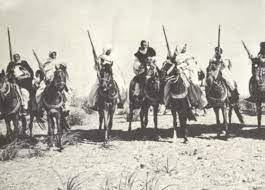Omar Al-Mukhtar:
(1858-1931)
"The sentence on you Omar Mukhtar is Death by hanging in Public."
"From God we come, and unto God, we shall return".
The National hero of Libya, revolutionist and member of the Senusy Omar AL-Mukhtar led a religious organization with administrative and military functions and led the anti-colonial resistance in Cyrenaica from 1923 to 1931 when he was captured by the Italians and condemned to death. He was called The Lion of the Desert, known among the Colonial Italians as Matari of the Monifa.
Though his date of birth is uncertain, he was born between 1856 and 1862. He learned Islam at an early age and became Hafiz after which he started to teach the Quran as a scholar till he came to the age of 53, it was the time when his life was about to take a new phase. During the Italian-Turk war in October, an Italian naval regiment arrived at the coast of Libya, then a territory subject which was under the control of Ottoman. Italian threatened Ottoman and their Libyan allies to surrender the Tripoli lands and city as they proclaimed that Tripolitanians are committed and strongly bound to Italy. Rather than surrending the Ottomans and Libyans withdrew to the countryside and the Italians bombarded the city for 3 consecutive days. This started the 22 years series of battles between Italian colonial forces and Omar Mukhtar in the east of Libya.
In 1923, the Italians openly attacked Senusy. Omar was one of the most activist figures in organizing and defending his homeland. he commanded the guerilla warfare that often battled and mystify the Italian forces. He was skilled in desert warfare, he had the advantage of minding the geography of that area well and used that against the Italians who were unfamiliar with desert warfare. Omar and his small group of men, skillfully attacked outposts, ambushed troops, and critically cut supply routes, astonishing and embracing, the highly advanced Italian Royal Army and its troops who were half of his age . In the mountainous region of Gebel Akhdar (The Green Mountain), in 1924, the Italian Governor Mombeli established a counter-guerrilla force, in 1925 that force crushed Omar's forces. But he managed to change his tactics and got persistent help from Egypt as well.
In 1926, Italian forces were able to occupy Giarabub, and in 1927, under then-Governor Teruzzi instead the reinforcement of the persecution, Omar left Italian forces surprised at Raheiba. After successive clashes in Gebel, Omar had to withdraw. Between 1927-1928 Omar reorganized the Senusite forces, who were being killed by Italian forces. Omar's Integrity and uprightness left General Teruzzi astonished and he recognized Omar's qualities of exceptional preservance and strong willpower.
In 1929, the then-new governor Pietro Badoglio of Tripolitania and Cyrenaica was able to comprise with Omar. But Italian forces falsely announced the situation that Omar has completely submitted, this statement was confirmed by Italian Leaders, including Badoglio himself. At the end of October 1929, Al-Mukhtar opposed the compromise and reestablished his army, and prepared himself for the combative confrontation with Rodolfo Graziani. After facing massive defeat, Graziani cooperated with Pietro, De Bono and Mussolini, and started making plans against Omar. The plan was to prevent any foreign help and breaking up the solidarity of the population, close the border of Egypt from the coast of Giarabub, and send the Gebel population (which was around 100k) to concentration camps on the coast.
At the beginning of 1931, the plans they made started to work in their favor and Omar was facing difficulties. his men were destitute from any help or reinforcement, and were traced on and hunted down by Italian forces and aircraft, Italians were also been aided by the local informers and spies. Despite these hardships, Omar did not loose his spirit and fought courageously, but unfortunately on 11 September 1931, he was ambushed near Slonta. His struggles of nearly 22 years came to an end when he was captured and within 3 days he face trials and was sentenced to death.
Omar was determined to defend his peoples from what Italian fascists' describes as the "Roman Reconquista". Omar's character and integrity impressed even his enemies sticking to Islamic principles during the hardships, and horrors of war and brutal occupation after 20 years of fighting, inflicting defeats and setbacks on the Italian invaders. Omar was captured at the age of 73. Though he was offered many deals and bribes to call off his men but he always refused with his famous words:
"We will never surrender, we win or we die".
On September 16, 1931, Al-Mukhtar was martyred, these were the last verse of the Quran he was reciting before his execution:
"Allah will say to the righteous, O tranquil soul!
Return to your lord, well pleased with him well-pleasing to Him
So join My Servant, and enter My Paradise".
(Surah- Al Fajar: 27-30)
After his execution he was honored and known as the Islamic Scholar who had vast knowledge of Islam.
- 1961 a university was founded after his name.
- Many of the streets were name after Al-Mukhtar in different countries such as Kuwait, Gaza city, Egypt, Qatar, Tunisia, Saudi Arabia, Jordan and Morocco.
- When Libyan Leader Muammar Gaddafi visited Rome, he wore a Picture of Omar Al-Mukhtar in Italian captivity on his chest, and also brought Al-Mukhatr's son along with him.




Comments
Post a Comment